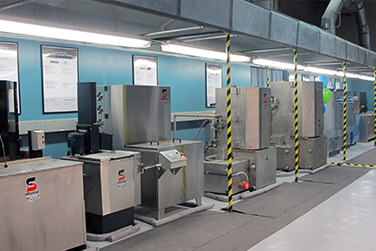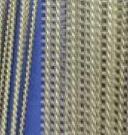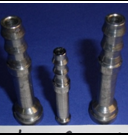
As more manufacturers are embracing sustainable manufacturing methods, technical colleges and universities are experiencing an increase in demand for graduates that can implement processes that incorporate methods of "pollution prevention," or P2.
As part of this process, companies are looking to develop “Green Cleaning” procedures, and one area of focus for this initiative is switching from traditional organic solvent cleaners used for parts cleaning applications to aqueous solutions, which are less toxic than those used traditionally. Most aqueous based cleaners such as those manufactured by ArmaKleen reduce VOCs to comply with strict air compliance regulations and are typically non-hazardous, non-flammable and bio-degradable in many cases.
Overall, the goal for implementation of “Green Cleaning” procedures is to balance the economic needs and company objectives for improving the health and safety of workers, while simultaneously reducing or even eliminating the environmental impact of chemicals and equipment used to clean machinery.
With the continued advancements made with aqueous cleaners and technologies, companies are finding that aqueous solutions clean as well if not better than traditionally used organic solvents. By switching to aqueous cleaners, companies are able achieve the desired environmental benefits while improving their bottom lines. Below are some of the top benefits companies are realizing when using aqueous cleaners:
• Reduce chemical and maintenance costs by extending chemical bath lives
• Reduce the risk for fire or explosions
• Reduce VOC’s
• Reduce health and safety risks
• Improve worker morale and working conditions
• Reduce hazardous waste generation
• Create more efficient processes for cleaning through automation
With the growing number of manufacturers adopting these types of sustainable business practices and realizing substantial financial and environmental benefits these practices provide technical colleges and vocational schools nationwide have increased their commitments to teaching sustainable business practices to their students.
"When you define sustainability, the true sense of the word is that it's development that meets the need of the present without compromising the ability of future generations to meet their own needs," said Michael Haselkorn, Ph.D., Senior Staff Engineer and member of Research Faculty at the Rochester Institute of Technology.
Curriculum
The courses universities, colleges, and technical schools offer teach students not only how aqueous solutions work, but also the various options that are available. Exactly what type of cleaner to use depends on the type of metal to be cleaned and the kind of soil to be removed.
For example, some metal machine parts have scale, rust, and oxides that must be removed. The best cleaners for that type of job are acidic aqueous solutions — water-based mixtures with pH less than seven, which contain mineral acids (hydrofluoric, sulfuric, phosphoric, nitric), chromic acids, or organic acids (acetic or oxalic). They might also include detergents, chelating agents, and small amounts of water-miscible solvents.
Other aqueous cleaners are alkaline mixtures with pH greater than seven. Most alkaline cleaners range from pH 10 to 14; those are the most common solutions in aqueous cleaning. Such cleaners often contain additives to boost cleaning, such as sequestering agents, emulsifiers, and surfactants. Parts cleaned with alkaline cleaners include hydraulic valve bodies, fuel injector components, and machined aluminum castings.
RIT, and other sustainable engineering programs, aim to establish a clear understanding of the role and impact of various aspects of engineering (design, technology, etc.) on environmental, societal, and economic problems. Students are taught how to apply engineering and decision-making tools and methodologies to sustainability-related problems. In addition, there is an emphasis on the trade-offs between environmental, social, and economic objectives. Understanding the cost savings potential of aqueous solutions is also critical for its continued — and increased — implementation in manufacturing.
Cost Savings
For any green initiative to be sustainable there has to be an economic balance achieved with a company’s overall financial goals and needs , so sustainable economic development requires students to learn how to conduct relevant risk analyses. Companies that want to run sustainably must understand the costs involved in changing their processes, but also know what their costs will be in the future by not changing. And that leads to the importance of engineering and technical students understanding the "circular economy." The circular economy focuses on companies following "reduce, reuse, recycle" strategies.
"If you look at manufacturing now, we have a linear process: You take something out of the ground, we make something, use it and then we throw it away," Haselkorn said. He referenced a 2012 report commissioned by the Ellen MacArthur Foundation: Towards the Circular Economy: Economic and business rationale for an accelerated transition. The report focuses on the potential for significant benefits within the European Union and postulates that a certain sector of manufacturing could see net materials cost savings of billions of dollars. Those savings can be reinvested to spur economic activity in the areas of product development, remanufacturing, and refurbishment.
Because many aqueous solutions and processes are automated, companies gain significant savings as employees are freed to work on other essential tasks while the soiled parts are cleaned and dried. By providing clean and dry parts to the next process, the aqueous process reduces component rejects and quality problems.
Next Steps
Universities, colleges, and technical schools that offer coursework in sustainability understand that the field is "transdisciplinary." It extends beyond science and into social and economic disciplines. As more manufacturing plants understand the environmental and economic benefits that accompany sustainability practices, demand for engineers with that knowledge will increase. Meeting that demand may require institutions of higher learning to take a number of steps, including:
• Creating a Sustainability Faculty Fellows Program
• Supporting Regional Centers for Sustainability that can provide professional development
• Developing a Collaborative for Sustainability Curriculum Change that can continue the dialogue
By providing coursework that teaches sustainability — and includes the importance of aqueous solutions such as those provided by ArmaKleen — schools can take a leadership role in educating engineers about parts cleaning methods that are better for workers' health and the environment, as well as manufacturers' bottom lines.
 As more manufacturers are embracing sustainable manufacturing methods, technical colleges and universities are experiencing an increase in demand for graduates that can implement processes that incorporate methods of "pollution prevention," or P2.
As more manufacturers are embracing sustainable manufacturing methods, technical colleges and universities are experiencing an increase in demand for graduates that can implement processes that incorporate methods of "pollution prevention," or P2.




